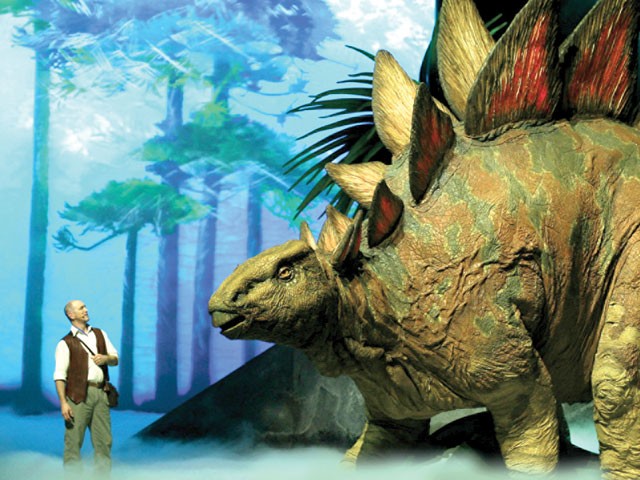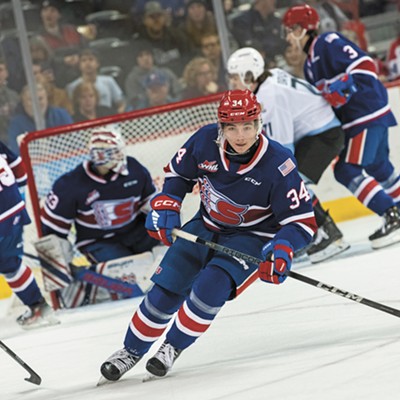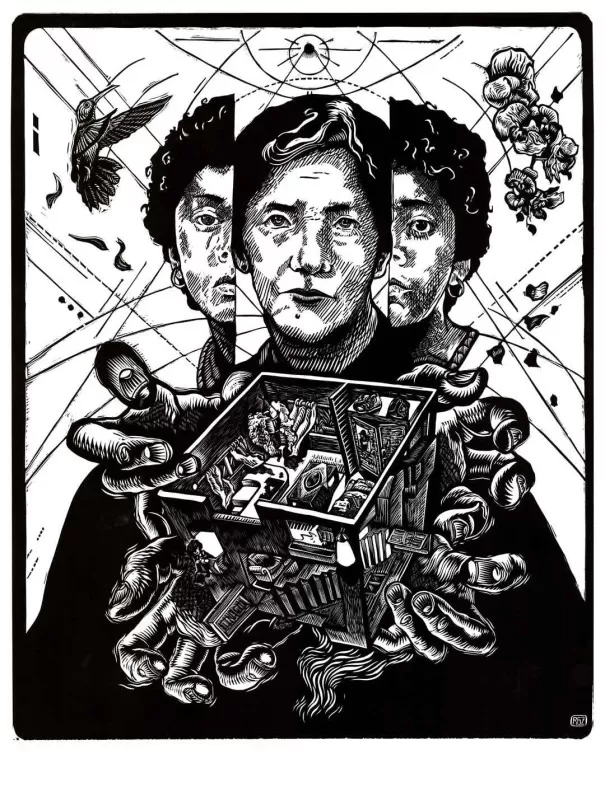“Steg travel ... Steg stop. Allo turn ... Allo travel....” A remote-control allosaurus is prowling the Spokane Arena floor, but up here in the stage manager’s booth, men with headsets are barking orders — and somebody had better say “Allo stop” pretty soon, or the folks in the front row are going to experience dinosaur carnage.
Up in the “Walking With Dinosaurs” booth, three puppeteers manipulate and pose three doll-size dinosaurs. When they move a stegosaurus doll’s leg, so moves the corresponding leg on the stegosaurus far below. Each of the voodoo-dino operators has an assistant (responsible for a dinosaur’s blinking and roaring) and down below, there’s a driver who’s sitting inside the animatronic beast itself.
But the real action is with the voodoo operators, and as the swing puppeteer for this prehistoric extravaganza — tonight he’s a plateosaurus; tomorrow, a T-Rex — Michael Latini has remote-guided every big lizard in the show.
“It feels a lot like playing Xbox,” he says. “All my years of playing videogames is finally paying off.”
Latini may be a puppeteer, but these are not hand-puppets: The thunder lizards that he controls are as big as your house. The mommy brachiosaurus, for example, stretches 56 feet from tail to snout. Add in primal roars and crashing comets — sound emanates both from the arena’s speakers and the thunder lizards themselves — and pretty soon, both children and adults are goggle-eyed.
“The kids may actually be a little less amazed than their parents,” Latini says. “Because the parents understand a little more of what it takes to operate one of these things, whereas some of the kids just accept that it’s a dinosaur. The adults are more like, ‘Wow, how are they doing this? I wanna go backstage and see how it’s done.’”
What they’d be most surprised by, Latini says, is all the empty space inside the dinosaurs. There are plenty of batteries, cables and microprocessors, “but these structures need to be light so they can move quickly,” Latini says — which means lots of carbon fiber. (“Quickly” is relative: the dinos do observe an 8 mph speed limit while on the arena floor.)
A steel framework forms a skeleton, with bungee cords acting as the tendons and hydraulic devices as the muscles. (Fill this cylinder with fluid, and the dinosaur’s skull turns right; empty it, and the pea-brain looks left.)
Still, the show’s creators needed to keep things light and save room for the drivers, who often “have a better visual” than the voodoo puppeteers up in the booth, as Latini explains: “When the dinosaurs are ‘feeding’ along the side of the stage, the drivers can see the lower jaw better.”
Back when Steven Spielberg was filming T-Rexes munching on Ford Explorers, animatronic contraptions “weren’t reliable enough to do a live show,” Latini says. And for the making of Jurassic Park in 1992, there were noticeable delays between command and execution — not to mention how the mechanical dinosaurs would break down in mid-roar. But improved software, Latini says, “allows us to manipulate these dinosaurs from second to second, instantaneously.” In addition, all that carbon fiber means smaller hydraulics and faster speeds.
For now, the dinos rest on “a T-shaped chassis, the same color as the floor,” Latini says. Feet may appear to touch the ground, but the dinosaurs’ legs aren’t actually weight-bearing. One and half tons rest on half a dozen roller blade wheels.
Ten years from now, Latini speculates, the technology will improve to where the dinos will be lumbering around on their own two (or four) feet. Which is when some of us will start running for the hills.
In case of breakdowns, however, the puppeteers have contingency plans; humans can intervene all along the way. “The walk cycle is the only thing that’s automated,” Latini says. “Whether the dinosaur is moving forward or backward, it automatically makes a walking motion. But the walk cycle can break down, too. And if we’re in a situation where the dinosaur is still moving along the floor but the legs are not walking, we call that ‘Dinos on Ice.’”
Because he rotates among all six stations in the voodoo lounge, Latini went through three months of training as a dino puppeteer (instead of the usual five weeks). He spent time at the zoo, watching the rhinos, elephants and giraffes; he studied the rapid neck-twisting movements of birds. Yet the most difficult aspect of performance in “Walking With Dinosaurs,” Latini says, involves filtering out all the chatter on his headset. What with the main sound system blaring out music and explosions, and the drivers and voodoo operators all talking at once, it can be difficult, on a given night, for a swing puppeteer to remember which particular dino he’s in charge of. (And yes, in mid-performance, he has told the plateosaurus to move when he meant the torosaurus.)
“Plat travel ... Toro turn....”
If it was supposed to be “Plat turn” and “Toro travel,” then both might experience “T-Rex crash.”
That’d get the kids’ attention.
“Walking With Dinosaurs — The Arena Spectacular” will bare its fangs at Spokane Arena on Wednesday-Friday, April 7-9, at 7:30 pm; on Saturday, April 10, at 11:30 am, 3:30 pm and 7:30 pm; and on Sunday, April 11, at 1 pm and 5 pm. Tickets: $40-$60. Visit spokanearena.com/dinos or call (800) 325-SEAT.





















